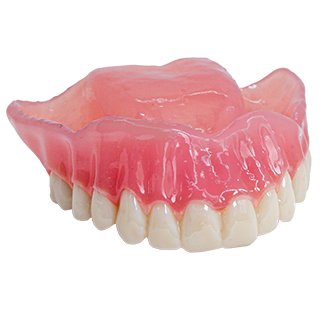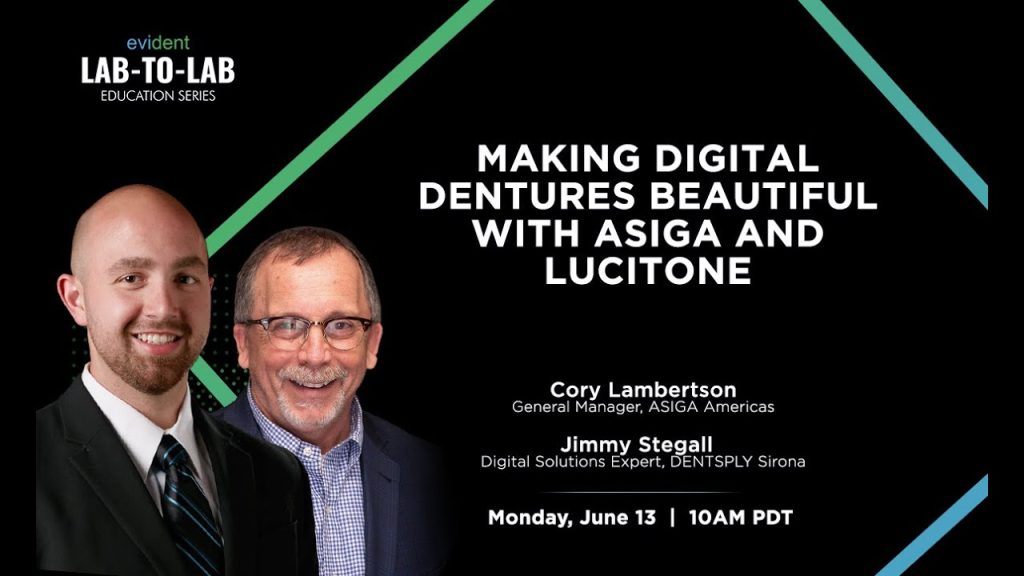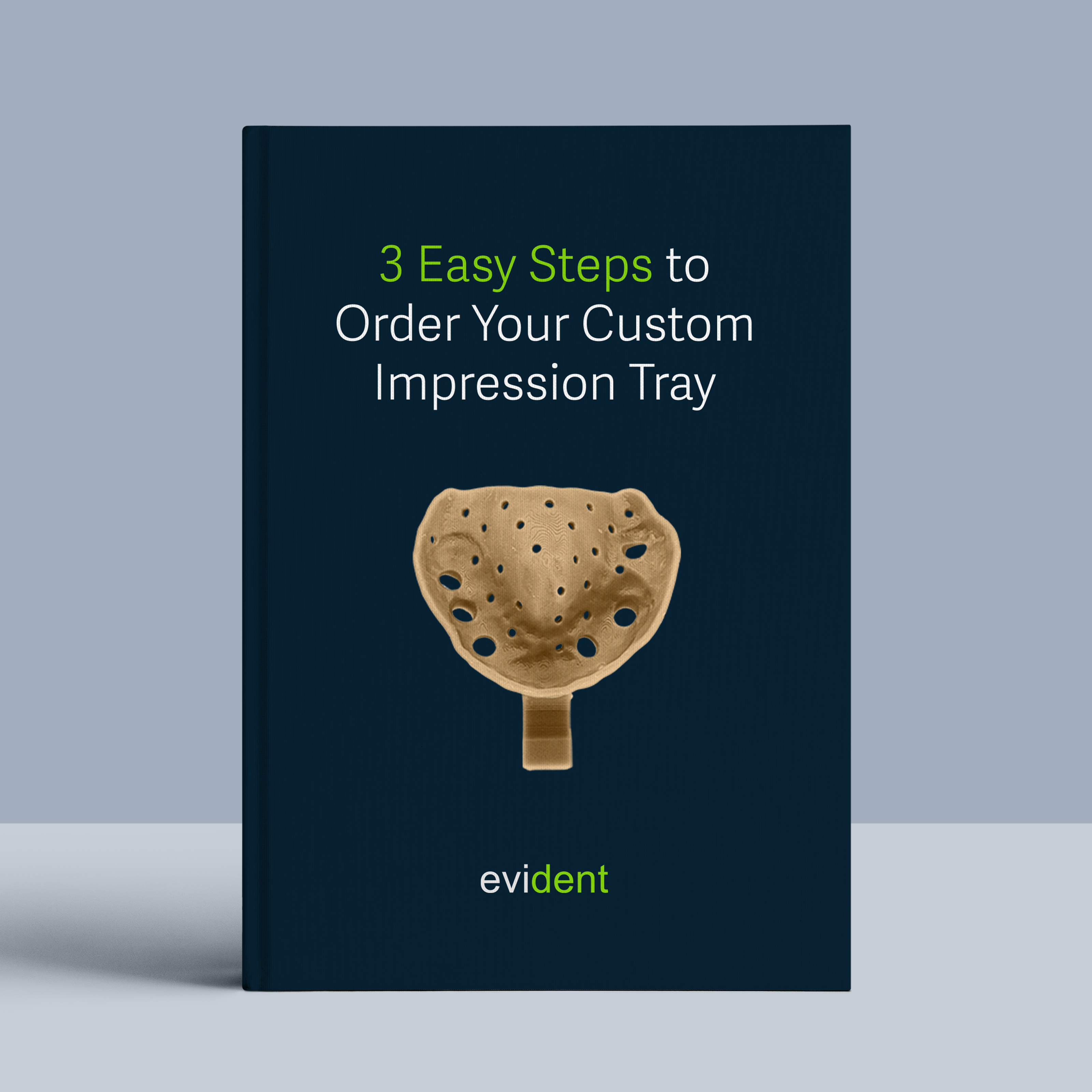
The technology to create dentures from a computer has already been developed. It’s in widespread use too. The only hindrance now to the quality of these 3D-printed dentures is how much more dental resins can innovate and advance.

Evident held a webinar interview with experts from Asiga and Dentsply to discuss digital dentures and how technicians can get into them.
Jimmy Stegall, an expert from Dentsply with over 40 years of lab experience, and Cory Lambertson, a CAD/CAM expert from Asiga, gave us their thoughts.
Why use Digital Dentures?
The dental industry has accelerated its development in the last decade. If dental labs haven’t already adopted digital dentures, they’ll be left behind by the technology and learning curve. Now, with the resins being innovated and perfected, the time to hop on is as soon as possible, if not now.
Here’s why:
Strength
Jimmy mentions that a Lucitone Resin-printed denture is three times stronger than acrylic. This is in terms of flexural strength, fracture toughness, and wear resistance. Jimmy explains that tests have been done at Boston University to validate this.
Aesthetics
During his lectures, Jimmy passes out two dentures, labeled “1” and “2,” to dentists. He has them pick their favorite one.
One of those is a carded tooth, and the other is a printed one that’s characterized by a ceramist. Jimmy states that 99% of the time, dentists would prefer the printed tooth over the carded one.
Dental resins have evolved to have the translucent properties that natural teeth have. This makes printed teeth appear more lifelike without compromising strength.
Fit
Using an intraoral (IOS) scanner instead of a traditional impression allows dentists to capture a much more accurate model of the patient’s teeth.
As a result, when dentures are designed with that digital reference, they’ll fit much better than those made using a hand-made diagnostic model as a reference.
In addition, 3D printing accurately prints out the designed digital denture to the finest detail. This truly brings to life a computer-designed denture, capturing every square micron of the design.
Ease Of Use
Jimmy can train young technicians to master every stage of the digital workflow (except designing) within a day. Jimmy elaborates, saying that with the digital workflow, he can get dental techs to be productive in their respective departments within a month or two.
Compared to the analog method that requires molding, investing, and sometimes casting, Jimmy says it can take three years before techs trained with this method become productive.
Jimmy also mentions that a team of five denture technicians can produce 24 dentures a day using traditional methods. However, keeping those same technicians and teaching them to use digital methods, Jimmy foresees them doing 32 dentures daily.
That’s a 33% increase in production!
Cost
Jimmy lays down the numbers: he could print a Lucitone resin base for $13 in material cost and print an arch of teeth for just $6. This means a full-arch removable denture could be made for as little as $19 in material costs.
This material cost is much more affordable than if Jimmy were to buy the required cards of teeth, which would set him back $90 per denture. So, having a digital denture workflow allows labs to have much better margins and ROI.
Pair this material cost with its ease of use. Because of how easy the digital denture workflow is, dental lab managers can maximize labor costs and efficiently utilize the existing manpower in the lab.
How does 3D Printing Compare to Milling?
Speed
Jimmy mentions that he can mill three arches from a puck in about two hours. However, he can print as many as nine arches of teeth in an hour.
As for a denture base, milling can produce one in four hours, whereas printing can do it in two.
So, printers running consecutively can produce two to three times the output that mills can within the same amount of time.
Undercuts
Subtractive manufacturing methods, such as milling, are limited by how deep the spindle or grinding device can reach. This results in some areas not being milled properly. Cory draws attention to the intaglio surface of a milled denture, which he states could have undercuts due to milling limitations.
But with additive manufacturing methods such as 3D printing, the denture is practically created out of thin air. This results in no undercuts and, hence, a perfect-fitting denture.
Solubility
In another interview, we had David Avery of SS White Dental give his thoughts on 3D printing. He believes that though printing creates a sturdy tooth, his concern is the solubility of that case.
David’s professional opinion is that milled cases last longer than printed ones due to the more solid nature of milled cases. Milled cases are less soluble than printed ones and, hence, last much longer in the mouth.
However, David’s also optimistic about the future of dental resins’ strength. Once resins achieve the strength and insolubility of milled blocks and pucks, 3D printing will be a massive game changer for the restorative dental industry — more than it already is.
How To Get Started with Digital Dentures
3D Printer
A 3D printer will allow dentists and dental techs to print a wide array of cases and components. Cory mentioned that he’s seen dentists get 3D printers just to print digital dentures. But once they start using the printer more often, they’ll find it useful for printing even splints.
Consumables
Consumables for the digital denture workflow include dental resins, adhesives and bonding agents, IPA for cleaning, and stains and glazes for finishing.
These will have to be resupplied on a regular basis.
Washer
Depending on how the printed material will be washed, dentists and labs may need to use a dedicated washing unit for their digital denture workflow.
Why would a washing unit be needed if dentists and techs can use a brush and cleaning solution? That’s because washers typically come with ultrasonic features that can help to better clean the printed unit. It requires less elbow grease too.
Curing Unit
Cory mentions that a lot of people try to skip getting a curing unit. However, curing is a crucial part of making digital dentures. A properly cured denture has adequate strength, utilizing premium dental resins to their fullest potential.
Cory continues, saying that patient safety would also be an issue if a denture wasn’t cured properly. So, getting the right curing unit will save dental labs from dental negligence and malpractice lawsuits.
The Challenge With Digital Dentures
Cory mentioned that in the entire fabrication process of digital dentures, the stage that takes the longest to learn is the design process, to which Jimmy nodded in approval.
Cory further explains that 3D printing is the easy part. Jimmy mentions that he can teach any dental tech to operate a 3D printer in “a couple of” hours.
Jimmy states that an effective way to address this learning gap is to get someone who already knows how to use the CAD/CAM software (e.g., 3Shape, exocad), have them work closely with a denture guy, and that designer will soon be able to design beautiful digital dentures.
Alternatively, dental labs may subcontract the digital design process.
Here at Evident, we’ve employed over a hundred expert designers who can digitally create a wide array of cases and components. This includes crowns, bridges, all-on-x, splints, and removable dentures.
We’re the go-to design supplier for thousands of labs. We’ve mastered our craft, so we can return to you a ready-to-print STL file in 24 hours or less.
Simply send us the IOS scans and the Rx, and we’ll do the rest. Give us a call to learn more.
Conclusion
Despite the aforementioned benefits, the adoption rate for digital dentures is still climbing. Jimmy mentions that out of the 6,000 labs in the US, he’s only trained about 140 of them in the past two years. Also, Evident’s audience poll shows that only 50% of the attendees use 3D printers in their workflow.
So, adopting digital dentures as early as today will give dental labs a competitive edge in the industry. They’ll be able to provide better service and manage more efficient business operations compared to their analog competitors.









